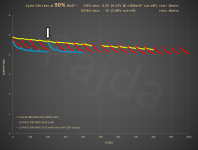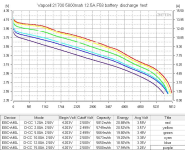I was considering starting a new topic with the clickbait "Do LIB really not suffer from the memory effect?", but I find it disrespectful to the community. The idea is based on the observation of my LIB cycle-life data, where you maybe noticed that cycling at a constant SoC range, lower than 100% produces so-called waves in the data. As it happens, some cells seems do not suffer much from this phenomenon and others have it very visible, which is the case of the LG INR21700 M58 model.
What is considered a memory effect in this case? It is a gradual loss of usable cell capacity during cycling, which is not permanent and can be restored.
What causes it in a real application? Long-term cycling within limited SoC window.
How capacity can be restored? The cell needs to be charged to 100% SoC.
Let's take a look at the M58 cycling data. Here we see a standard cycling life test with 0.5C-chg and 1C-dchg settings with limited SoC window to 4.15V-3.00V (ca 90%) for 49 cycles. This setting is the same for all three samples in the graph. The difference is caused by the nominal capacity test, which is inserted every 50 cycles. For red (M58) and yellow (F60) samples the nominal capacity test cover 100% SoC which is 4.20V-2.50V, but for blue sample (M58) this nominal capacity test is limited to 4.15-3.00V (the same SoC as for cycling) where in the 200th cycle a full 100% SoC cycle 4.20V-2.50V is inserted to demonstrate this phenomenon.
Also, you may have noticed that the blue sample (M58) experiences little capacity recovery even when the nominal capacity test is inserted with the same 4.15-3.00 SoC. This is due to the fact that the nominal discharge rate 0.2C is here used to discharge instead of the test 1C rate. Thus, the cell discharges deeper (to lower OCV voltage) at 0.2C due to the effect of cell IR.
So the conclusion is that some cells like F60 sample does not suffer significantly from the memory effect, but with the M58 you can lose a significant amount of usable energy during the life cycle of the pack thanks to this phenomenon.



